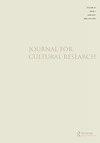“你觉得被抓住了吗?”性别、群体和情感设计
IF 0.6
Q1 CULTURAL STUDIES
引用次数: 0
摘要
摘要Ari Aster的2019年民间恐怖电影《仲夏夜》在评论界和大众中都获得了成功,它以明亮的调色板和诡异的戏谑基调为特色,同时以黑暗的叙事探索悲伤、抑郁和糟糕关系的复杂性。主人公丹妮、她的男朋友和他的朋友们前往一个偏远的瑞典社区参加仲夏电影节,这个社区围绕着美丽的物品、集体体验和仪式设计,这些都预示着共同的情感,所有这些都与电影一开始就以技术为媒介的交流形成了鲜明对比。事实上,这个社区为现代世界的孤独感和西方男性情感距离的理想提供了精心构建的解药……但这是有代价的。本文探讨了《仲夏夜》中情感、社区和性别的交叉点,使用情感设计的概念——通常与技术设计相关——以及基于群体的情感,来质疑电影对一个挑战性别规范和情感体验边界的社区的愿景。《仲夏夜》通过对内部群体边界治安的描述、男性气概的愿景之间的鲜明对比,以及对审美体验和情感释放的丰富愿景,提供了一系列令人信服的补偿机制,邀请观众和主角为了归属感而暂时妥协于道德。本文章由计算机程序翻译,如有差异,请以英文原文为准。
‘“Do you feel held?”: gender, community, and affective design in midsommar’
ABSTRACT Ari Aster’s 2019 folk horror film Midsommar, which enjoyed both critical and popular success, features a bright colour palette and an eerily playful tone alongside a dark narrative exploring complexities of grief, depression, and bad relationships. The remote Swedish community to which protagonist Dani, her boyfriend, and his friends travel for a mid-summer festival is designed around beautiful objects, collective experiences, and rituals that foreground communal emotions, all of which contrast the technologically mediated communications foregrounded at the film’s outset. In fact, this community offers meticulously constructed antidotes to the loneliness of the modern world, and to Western ideals of masculine emotional distance…but at a cost. This paper examines the intersection of emotion, community, and gender in Midsommar, using the concept of affective design – usually associated with technology design – as well as work on group-based emotions, to interrogate the film’s vision of a community that challenges gender norms and the boundaries of emotional experience. Through the depiction of ingroup boundary-policing, stark contrasts between visions of masculinity, and lush visions of aesthetic experience and emotional release, Midsommar offers a series of convincing compensatory mechanisms that invite viewers, along with the main character, to temporarily compromise morality for the sake of belonging.
求助全文
通过发布文献求助,成功后即可免费获取论文全文。
去求助
来源期刊

Journal for Cultural Research
CULTURAL STUDIES-
CiteScore
1.40
自引率
0.00%
发文量
23
期刊介绍:
JouJournal for Cultural Research is an international journal, based in Lancaster University"s Institute for Cultural Research. It is interested in essays concerned with the conjuncture between culture and the many domains and practices in relation to which it is usually defined, including, for example, media, politics, technology, economics, society, art and the sacred. Culture is no longer, if it ever was, singular. It denotes a shifting multiplicity of signifying practices and value systems that provide a potentially infinite resource of academic critique, investigation and ethnographic or market research into cultural difference, cultural autonomy, cultural emancipation and the cultural aspects of power.
 求助内容:
求助内容: 应助结果提醒方式:
应助结果提醒方式:


